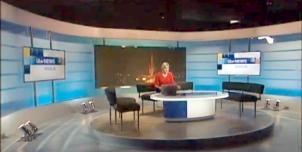Full Freeview on the Sudbury (Suffolk, England) transmitter
| Google Streetview | Google map | Bing map | Google Earth | 52.005,0.786 or 52°0'17"N 0°47'8"E | CO10 5NG |
The symbol shows the location of the Sudbury (Suffolk, England) transmitter which serves 440,000 homes. The bright green areas shown where the signal from this transmitter is strong, dark green areas are poorer signals. Those parts shown in yellow may have interference on the same frequency from other masts.
This transmitter has no current reported problems
The BBC and Digital UK report there are no faults or engineering work on the Sudbury (Suffolk, England) transmitter._______
Digital television services are broadcast on a multiplexes (or Mux) where many stations occupy a single broadcast frequency, as shown below.
64QAM 8K 3/4 27.1Mb/s DVB-T MPEG2
H/V: aerial position (horizontal or vertical)
The Sudbury (Suffolk, England) mast is a public service broadcasting (PSB) transmitter, it does not provide these commercial (COM) channels: .
If you want to watch these channels, your aerial must point to one of the 80 Full service Freeview transmitters. For more information see the will there ever be more services on the Freeview Light transmitters? page.
Which Freeview channels does the Sudbury transmitter broadcast?
If you have any kind of Freeview fault, follow this Freeview reset procedure first.Digital television services are broadcast on a multiplexes (or Mux) where many stations occupy a single broadcast frequency, as shown below.
64QAM 8K 3/4 27.1Mb/s DVB-T MPEG2
H/V: aerial position (horizontal or vertical)
The Sudbury (Suffolk, England) mast is a public service broadcasting (PSB) transmitter, it does not provide these commercial (COM) channels: .
If you want to watch these channels, your aerial must point to one of the 80 Full service Freeview transmitters. For more information see the will there ever be more services on the Freeview Light transmitters? page.
Which BBC and ITV regional news can I watch from the Sudbury transmitter?

BBC Look East (East) 0.8m homes 3.2%
from Norwich NR2 1BH, 77km north-northeast (24°)
to BBC East region - 27 masts.
70% of BBC East (East) and BBC East (West) is shared output

ITV Anglia News 0.8m homes 3.2%
from NORWICH NR1 3JG, 78km north-northeast (24°)
to ITV Anglia (East) region - 26 masts.
All of lunch, weekend and 80% evening news is shared with Anglia (West)
Are there any self-help relays?
| Felixstowe West | Transposer | 1000 homes +1000 or more homes due to expansion of affected area? | |
| Witham | Transposer | 14 km NE Chelmsford. | 118 homes |
How will the Sudbury (Suffolk, England) transmission frequencies change over time?
| 1984-97 | 1997-98 | 1998-2011 | 2011-13 | 1 Aug 2018 | |||||
| B E T | B E T | B E T | E T | K T | |||||
| C29 | SDN | ||||||||
| C31 | ArqA | ||||||||
| C35 | C5waves | C5waves | |||||||
| C37 | ArqB | ||||||||
| C41 | ITVwaves | ITVwaves | ITVwaves | D3+4 | D3+4 | ||||
| C44 | BBC2waves | BBC2waves | BBC2waves | BBCA | BBCA | ||||
| C47 | C4waves | C4waves | C4waves | BBCB | BBCB | ||||
| C51tv_off | BBC1waves | BBC1waves | BBC1waves | ||||||
| C56tv_off | ArqB | ||||||||
| C58tv_off | SDN | ||||||||
| C60tv_off | -ArqA |
tv_off Being removed from Freeview (for 5G use) after November 2020 / June 2022 - more
Table shows multiplexes names see this article;
green background for transmission frequencies
Notes: + and - denote 166kHz offset; aerial group are shown as A B C/D E K W T
waves denotes analogue; digital switchover was 6 Jul 11 and 20 Jul 11.
How do the old analogue and currrent digital signal levels compare?
| Analogue 1-4 | 250kW | |
| SDN, ARQA, ARQB, BBCA, D3+4, BBCB | (-4dB) 100kW | |
| Analogue 5 | (-7dB) 50kW | |
| Mux 2* | (-14.9dB) 8.1kW | |
| Mux B* | (-15.2dB) 7.5kW | |
| Mux 1* | (-15.5dB) 7kW | |
| Mux A* | (-17dB) 5kW | |
| Mux C* | (-22.2dB) 1.5kW | |
| Mux D* | (-23.6dB) 1.1kW |
Which companies have run the Channel 3 services in the Sudbury transmitter area
|
|
Wednesday, 4 July 2012
N
Nick6:56 PM
Aldeburgh
Please would someone explain what is meant by 'line of sight' re tv transmissions? Presumably this does not mean that with sufficient magnification we could see the transmitter. I ask as Dave kindly said from my location Dover was 66 miles, line of sight. Apart from North Kent, there is just sea between here and Dover, and the curvature of the earth means there is a huge wall of water between.
Incidentally, it was only in summer I could get good analogue from Dover, with C4 particularly unwatchable in winter, so guess I am currently getting some help to get all digital channels. In winter the signal could vary significantly minute to minute, sea mist being suggested as the cause. Thanks.
| link to this comment |
Nick's: mapN's Freeview map terrainN's terrain plot wavesN's frequency data N's Freeview Detailed Coverage
R
Russell Battle7:30 PM
Had new high gain aerial fitted yesterday. All the channels are back. Had to do a complete new auto tune to get them back all is good now. I tried to add new channels first, no good.
| link to this comment |
Les Nicol
7:46 PM
7:46 PM
Nick - Line of sight in simple terms means that you have no immediate obstruction i.e. Trees, Buildings, Ground terrain obstuctive issues that may impede the digital signal coming to your TV via your TV aerial from the transmitter. Unlike the analgue transmissions the digital transmission is precise similar to that received by satellite to a satellite dish. If you have an unobstructive clear line of sight to the tramsmitter and everything locally in terms of your aerial, connectivity etc should see you free of any recxeption issues. Satellite reception can be a little bit more problamatic in certain weather conditions extreme heavy rain or snow build up on the LNB - the item that's seen on the end of the dish boom arm. In this scenario it's a case of usually a brief or interrupted signal signal.
| link to this comment |
N
Nick8:17 PM
Aldeburgh
Thanks Les, but what about all that sea? I can't see beyond a few miles from my upstairs window which overlooks Dover, theoretically, nor can my aerial, because of the curvature of the earth giving me 60 odd miles of deep water in the way.
| link to this comment |
Nick's: mapN's Freeview map terrainN's terrain plot wavesN's frequency data N's Freeview Detailed Coverage
N
Nick8:24 PM
Aldeburgh
Why is it that the info, top, is out of date re xmitter power/frequencies, yet there is a seemingly current message about xmitter works?
On the other page about Sudbury switchover it says xmitter works from 18 June for a week, so how do we know if they have finished?
| link to this comment |
Nick's: mapN's Freeview map terrainN's terrain plot wavesN's frequency data N's Freeview Detailed Coverage
Thursday, 5 July 2012
M
Mark Fletcher1:11 AM
Halifax
Nick,Aldeburgh.Oddly enough i did mention in my text on Wednesday 27 June 2012,1.40pm then on my hols in St Annes on Sea,Lancashire in my first paragraph that the Sudbury page requires updating due to the COM multiplexes increasing in strength to 100kw apiece,albeit i forgot to mention the change in frequencies back then.
Im sure Briantist the owner of this ever valuable and useful website will ultimately update this page in due course once he catches up with the Sudbury pages,after all he is a very busy man assisting us all.
| link to this comment |
Mark's: mapM's Freeview map terrainM's terrain plot wavesM's frequency data M's Freeview Detailed Coverage
Les Nicol
6:55 AM
6:55 AM
Nick - The sea shouldn't make any difference it's the transmitter coverage - whether it's a main or relay transmitter and their respective outputs. In most cases an existing aerial should suffice, but if your on the fringes of a transmitter(s) you may well need to consider if a particular aerial, cabling etc is up to the job. Alternaitvely as in my area Low Powered Relay transmitters and ground terrain and obstruction issues often dictate the installation of "Freesat" service over "Freeview".
| link to this comment |
D
david8:14 AM
Eye
could someone update the transmitter power info etc. - it is STILL showing the pre-DSO levels
| link to this comment |
david's: mapD's Freeview map terrainD's terrain plot wavesD's frequency data D's Freeview Detailed Coverage
N
Nick8:46 AM
Aldeburgh
Thanks Mark.
Les, I am afraid I still do not follow your reasoning about the sea. I have a shed at the bottom of my garden where I play about with tellies. I cannot get my local transmitter, Sudbury, as there is a tree in the neighbour's garden.
I can, however, get Dover as it comes from a different direction with no tree in the way. There is, however, a wall of sea, probably 50 miles thick due to the curvature of the earth between here and Dover 66 miles away.
What is the difference between that tree and the wall of water?
| link to this comment |
Nick's: mapN's Freeview map terrainN's terrain plot wavesN's frequency data N's Freeview Detailed Coverage
Nick: I used Megalithia to plot the terrain between you and Dover:
Terrain between ( m a.g.l.) and (antenna m a.g.l.) - Optimising UK DTT Freeview and Radio aerial location
The curvature of the Earth would appear to be exagerated which is what I've experienced with Megalithia before over such long distances. What I did then was click the link below the plot to view the map between the two points.
I then found the co-ordinates for the point on the Kent coast where the signal path line intersects; this is at Birchington.
A plot from Dover to this point shows that there is clear line of sight:
Terrain between ( m a.g.l.) and (antenna m a.g.l.) - Optimising UK DTT Freeview and Radio aerial location
Unless there is any obstruction between your house and the coast, then this would appear to suggest that you do have line of sight to the top of the Dover mast.
The curvature of the Earth is said to be 8 inches per mile. This works out as 13.4 metres over the 66 miles.
| link to this comment |
Select more comments
Your comment please!




